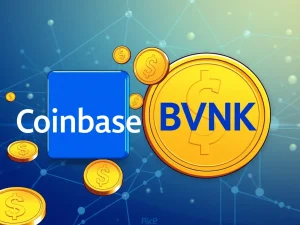Blockchain Revolutionizing Global Trade: Building a Resilient Parallel Economy

In an era marked by geopolitical shifts and trade tensions, traditional global trade mechanisms face unprecedented disruption. Tariffs and sanctions, once targeted tools, now create widespread chaos, fracturing established supply chains and challenging the very foundations of international commerce. Yet, amidst this uncertainty, a powerful new infrastructure is quietly emerging: **blockchain**. This technology is not just about cryptocurrencies or decentralized finance; it’s becoming the backbone of a resilient **parallel economy**, offering solutions where traditional systems falter.
How Tariffs and Sanctions Impact Global Trade
The re-emergence of protectionist policies, like those focused on tariffs and sanctions, significantly impacts **global trade**. These measures, while sometimes aiming to reshape production or exert political pressure, often lead to unintended consequences:
- **Liquidity Drain:** Sanctions disrupt financial flows, making it hard for businesses, especially small and medium enterprises (SMEs), to access capital and finance operations. Banks become risk-averse and pull back.
- **Supply Chain Fracturing:** Established routes and relationships are broken overnight, leading to uncertainty and increased costs.
- **Erosion of Trust:** The politicization of financial systems reduces trust in traditional intermediaries like banks and clearing systems.
- **Compliance Complexity:** Proving the origin and routing of goods becomes a critical, complex challenge, risking secondary sanctions.
This environment creates a pressing need for alternative systems that can bypass these challenges and restore functionality to international business.
Tokenization: Unlocking Liquidity in a Parallel Economy
One of the most significant responses to the liquidity crunch caused by sanctions is the rise of **tokenization**. This process involves representing real-world assets (RWAs) on a blockchain. Assets like trade receivables, commodities, or logistics slots can be fractionalized and sold on global permissioned marketplaces. This has several key benefits:
- **Enhanced Liquidity:** Companies can access capital by selling tokenized assets outside traditional, sanctioned financial corridors. Where sanctions reduce liquidity, tokenization creates it.
- **New Secondary Markets:** A new era is emerging with robust secondary markets for these tokenized trade assets, providing more avenues for financing and investment.
- **Fractional Ownership:** Breaking down large assets into smaller tokens makes them accessible to a wider pool of investors globally.
Within the economic disruption, tokenization presents a powerful opportunity to build financial pathways independent of legacy systems.
Stablecoins: The New Artery for Sanction-Neutral Payments
Beyond asset representation, **stablecoins** are proving to be vital components of this emerging **parallel economy**. Initially seen primarily as tools for DeFi, stablecoins like USDC, USDT, and EURC are now facilitating international trade payments, especially as traditional fiat rails face geopolitical pressure and disruption.
Why are stablecoins becoming financial lifelines for businesses from Latin America to Southeast Asia? They offer distinct advantages:
- **24/7 Processing:** Payments settle around the clock, without relying on traditional banking hours or intermediaries.
- **Border-Neutral:** Transactions occur peer-to-peer or via decentralized networks, bypassing traditional SWIFT or correspondent banking routes susceptible to sanctions.
- **Programmable Payments:** Using smart contracts, payments can be tied to specific conditions or compliance checkpoints, adding a layer of automated trust and accountability.
Stablecoins enable a shadow banking system for the sanctioned world, offering faster, cheaper, and more resilient cross-border transactions.
Onchain Provenance and Compliance Through Blockchain
Sanctions also highlight the critical need for transparency and traceability. Companies must prove the origin and routing of goods to avoid penalties. **Blockchain** technology is uniquely positioned to address this through onchain provenance.
Tokenized assets can embed immutable metadata directly onto the blockchain. This includes:
- Certificates of origin
- Shipping routes
- Customs approvals
- Source of raw materials
This provides real-time, tamper-proof compliance data, far surpassing outdated spreadsheets or siloed databases. Manufacturers can verify the compliance of every component used, building trust and reducing risk in complex **global trade** networks.
Decentralized Finance (DeFi) Infrastructure and Tokenized Escrow
The erosion of trust in traditional banks within high-risk corridors necessitates new trust mechanisms. Decentralized Finance (DeFi) infrastructure and specifically tokenized escrow offer meaningful options.
Tokenized escrow, enforced by smart contracts, allows milestone-based payments to be released automatically based on code, not reliance on a potentially compromised bank. This enables international deals to proceed without traditional clearing systems, maintaining accountability even when trust in conventional intermediaries is low. When sanctions weaken banks, code can step in as the neutral counterparty.
Building Resilience: Neutral Blockchain Hubs
The deepening geopolitical fractures are also creating opportunities for new digital infrastructure locations. As supply chains become politicized, the concept of ‘compliance-first’ trade hubs located in neutral countries (like Singapore, UAE, Turkey) gains traction. These hubs leverage **tokenization** to represent physical assets like ports, warehouses, and logistics routes onchain.
By embedding compliance and origin data directly into the asset’s lifecycle from the start, these hubs offer companies a trustworthy alternative in a fraught environment. They provide a resilient foundation for trade, less susceptible to the political pressures impacting traditional infrastructure.
Smart Contracts: Dynamic Responses to Regulatory Shifts
Legacy contracts struggle to adapt quickly to sudden regulatory changes like sanctions. They are static and hard to amend. Tokenized smart contracts, however, offer dynamic reactivity.
The logic embedded in these contracts can be programmed to respond to specific conditions. For example, a supplier could tokenize an invoice with a smart contract programmed to release payment only if goods clear non-restricted jurisdictions. This level of programmable compliance significantly reduces legal risk, operational delays, and cross-border tension.
The Backbone of a Parallel Economy
The challenging economic environment created by tariffs and sanctions is undeniably painful for many. However, it is also accelerating the adoption of **blockchain** technology as a foundational layer for a new, **parallel economy**. Tokenization, stablecoins, and smart contracts are doing more than just increasing efficiency; they are building a system that is inherently more resilient to geopolitical pressures.
This emerging infrastructure adapts faster than banks, negotiates through code better than complex legal amendments, and operates beyond the direct reach of traditional sanctions. Blockchain isn’t merely recording trade; it’s enforcing geopolitical logic at the asset level. As the next economic map is drawn onchain, the broad benefits of tokenization and blockchain in creating a more robust **global trade** system are becoming abundantly clear.







